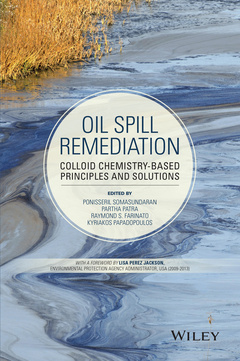Description
Oil Spill Remediation
Colloid Chemistry-Based Principles and Solutions
Authors: Somasundaran Ponisseril, Patra Partha, Farinato Raymond S., Papadopoulos Kyriakos
Language: English
Subjects for Oil Spill Remediation:
Keywords
Oil Spill Remediation Colloid Chemistry-Based Principles and Solutions; Ponisseril Somasundaran; regulations on toxic impact of oil and dispersants; EPA; environment assessment tools; dispersants; physicochemical and colloidal aspects oil spill cleanup; phenols; BTEX; gel-like agglomerations; bioremediation accelerators; oleophilic; hydrophobic chemical
163.43 €
In Print (Delivery period: 14 days).
Add to cart392 p. · 16.3x24.3 cm · Hardback
Description
/li>Contents
/li>Biography
/li>
? First book to address oil spill remediation from the perspective of physicochemical and colloidal science
? Discusses current and emerging detergents used in clean-ups
? Includes chapters from leading scientists, researchers, engineers, and policy makers
? Presents new insights into the possible impact of oil spills on ecosystems as well as preventive measures
Foreword vii
Preface ix
Contributors xi
1 Science-Based Decision Making on the Use of Dispersants in the Deepwater Horizon Oil Spill 1
Albert D. Venosa, Paul T. Anastas, Mace G. Barron, Robyn N. Conmy, Marc S. Greenberg, and Gregory J. Wilson
2 Understanding and Properly Interpreting the 2010 Deepwater Horizon Blowout 19
Sean S. Anderson, Charles H. Peterson, Gary Cherr, Richard Ambrose, Shelly Anghera, Steve Bay, Michael J. Blum, Rob Condon, Thomas Dean, William (Monty) Graham, Michael Guzy, Stephanie Hampton, Samantha Joye, John Lambrinos, Bruce Mate, Douglas Meffert, Sean Powers, Ponisseril Somasundaran, Robert Spies, Caz Taylor, and Ronald Tjeerdema by Nceas Gulf Oil Spill Ecotox Working Group
3 Remediation and Restoration of Northern Gulf of Mexico Coastal Ecosystems Following the Deepwater Horizon Event 59
Michael J. Blum, Brittany M. Bernik, Thomas Azwell, and Eric M.V. Hoek
4 Challenges in and Approaches to Modeling the Complexities of Deepwater Oil and Gas Release 89
Rupesh K. Reddy, A. Rao, Z. Yu, C. Wu, K. Nandakumar, L. Thibodeaux, and Kalliat T. Valsaraj
5 Oil Films: Some Basic Concepts 127
Johan Sjöblom and Sébastien Simon
6 Remediating Oilfield Waste and Spills 161
Raymond S. Farinato
7 Multipronged Approach for Oil Spill Remediation 175
Partha Patra and Ponisseril Somasundaran
8 Packed-Bed Capillary Microscopy on BP-Oil-Spill Oil in Porous Media 189
Peixi Zhu, Qing Wang, Yuly A. Jaimes-Lizcano, and Kyriakos Papadopoulos
9 Jameson Cell Technology for Organics Recovery 221
Graeme J. Jameson
10 Development of Gelling Agent for Spilled Oils 231
Kazutami Sakamoto
11 Microstructures of Capped Ethylene Oxide Oligomers in Water and n-Hexane 247
Mangesh I. Chaudhari and Lawrence R. Pratt
12 Some Colloidal Fundamentals in Oil Spill Remediation: The Water/Surfactant/Hydrocarbon Combination 259
S. E. Friberg, H. Hasinovic, and Pi Belobrov
13 Physicochemical Properties of Heavy Oil–Water Interface in the Context of Oil Removal from Seawater by Froth Flotation 279
Louxiang Wang, Meghan Curran, Meijiao Deng, Qingxia Liu, Zhenghe Xu, and Jacob Masliyah
14 Measurement of Interfacial Tension in Hydrocarbon/Water/Dispersant Systems at Deepwater Conditions 295
Mohamed A. Abdelrahim and Dandina N. Rao
15 Surfactant Technologies for Remediation of Oil Spills 317
Edgar J. Acosta and Suniya Quraishi
16 Role of Structural Forces in Cleaning Soiled Surfaces 359
Darsh Wasan, Alex Nikolov, and Gopi Sethumadhavan
Index 371
Ponisseril Somasundaran, PhD, is Chairman of the Henry Krumb School at Columbia University and is currently on the board of the new United Engineering Foundation. He has authored/edited fifteen books and over 700 scientific publications and patents.
Partha Patra, PhD, isResearch Scientist at Columbia University in New York. His research efforts focus on dealing with challenges associated with earth resource recovery and management, and development of engineering tools to promote usage of bioreagents in personal care, pharmaceuticals and food industries.
Raymond S. Farinato, PhD,is currently a Senior Research Fellow in the In Process Separation department of Cytec Industries Inc. and an adjunct professor in the Earth & Environmental Engineering department at Columbia University.
Kyriakos Papadopoulos, PhD, is Professor of Chemical & Biomolecular Engineering. His capillary video-microscopy technique has been used in studies of dermal delivery of vaccines, oil-spill cleanup and improvement of engine lubricant oils.



